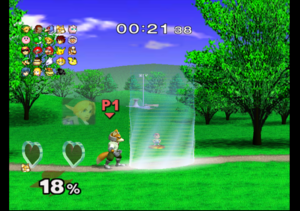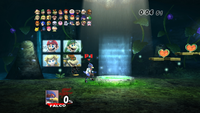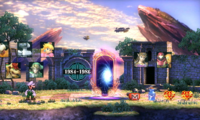All-Star Mode: Difference between revisions
| Line 212: | Line 212: | ||
[[File:Rest Room 3DS.png|thumb|The All-Star Mode [[Rest Station]] in [[Super Smash Bros. for Nintendo 3DS]]]] | [[File:Rest Room 3DS.png|thumb|The All-Star Mode [[Rest Station]] in [[Super Smash Bros. for Nintendo 3DS]]]] | ||
The order in which different characters are fought is now based on a character's personal first appearance. | The order in which different characters are fought is now based on a character's personal first appearance. | ||
Stated during the [[Nintendo Direct|''Super Smash Bros.'' Direct]], it is known that [[Assist Trophies]] "will figure into All-Star Mode" in some fashion, which is currently unknown. Unlike previous installments, All-Star Mode is playable from the start of the game. However, the mode will be incomplete unless all characters are unlocked. Unlike the previous games, there is only one Special [[Heart Container]] (Healing 999%), along with a [[Maxim Tomato]] (Healing 50%) and a [[Fairy Bottle]] (Healing 100%); after all characters are unlocked, an additional Heart Container will be available. | Stated during the [[Nintendo Direct|''Super Smash Bros.'' Direct]], it is known that [[Assist Trophies]] "will figure into All-Star Mode" in some fashion, which is currently unknown. Unlike previous installments, All-Star Mode is playable from the start of the game. However, the mode will be incomplete unless all characters are unlocked. Unlike the previous games, there is only one Special [[Heart Container]] (Healing 999%), along with a [[Maxim Tomato]] (Healing 50%) and a [[Fairy Bottle]] (Healing 100%); after all characters are unlocked, an additional Special Heart Container will be available. | ||
{| class="wikitable" align="center" | {| class="wikitable" align="center" | ||
Revision as of 13:50, October 1, 2014
All-Star Mode (オールスター, Ōrusutā) is a gameplay mode, available in Super Smash Bros. Melee, Super Smash Bros. Brawl, and Super Smash Bros. 4 that pits the player against every playable character in the game. The character chosen has only one stock in this mode. In Melee and Brawl, it is unlocked by unlocking every character within the game, but it is available from the start in SSB4.
Super Smash Bros. Melee
All-Star Mode made its debut in Super Smash Bros. Melee, as an unlockable 1-player mode which puts the player up against every playable character in the game. Each battle selects a number of characters at random, fighting every character once - the only character immune to this is Mr. Game and Watch, whom is always fought last, in a team of 25. Each opponent faced wears up to 3 of the alternate costumes, with the exception of Mr. Game & Watch, who always wears his default (unless the player uses Mr. Game & Watch in his default costume, in which case the Game & Watches will instead use their red costume). If the player uses a character with an alternate costume and the player faces the same character, the character will either use up to 2 of the alternates, or use the default costume. The characters are fought on the "home stages" of the first member on the list (for example, if the team was Luigi, Pikachu, and Ice Climbers, the stage would be Mushroom Kingdom).
For the first four battles, the player battles against one opponent. After four battles, the player will battle against two opponents per battle. After eight battles, the player will battle against three opponents per battle until the last fight against Team Mr. Game & Watch.
Unlike Classic Mode and Adventure, the player's percentage does not revert to 0% in between battles; players can only recover health by using one of three Heart Containers available between matches located in the All-Star Teleporter. These Heart Containers, unlike normal containers, heal the player up to 999% (restoring the player to 0%, as they did in the original SSB) instead of only healing 100% damage. However, if the player enters the portal while damage is being healed, then the damage will not heal any further, and the next match will start with the same amount of damage the player had when he or she entered the portal.
While players can use Ness's PSI Magnet and Mr. Game & Watch's Judgement to recover health, there is no other way to recover with the exception of the Heart Containers; items such as food, Maxim Tomatoes, and eggs do not appear at all in the mode.
As a reward, the player can also collect random trophies that appear after the third, sixth, ninth, and twelfth battles.
For characters with a home stage set outside their universe, the stage will have a more appropriate track from their series play; this acts as the only time these tracks can play on these stages. For instance, Pichu's stage is set as Fourside, but the "Battle Theme" plays. The only exception is Ganondorf, for whom the normal Brinstar Depths music is played.
| First character | Stage |
|---|---|
| Dr. Mario | Mushroom Kingdom II (Dr. Mario) |
| Mario | Rainbow Cruise |
| Luigi | Mushroom Kingdom |
| Bowser | Yoshi's Island (Super Mario Bros. 3) |
| Peach | Princess Peach's Castle |
| Yoshi | Yoshi's Story |
| Donkey Kong | Kongo Jungle |
| Captain Falcon | Mute City |
| Ganondorf | Brinstar Depths |
| Falco | Venom |
| Fox | Corneria |
| Ness | Onett |
| Ice Climbers | Icicle Mountain |
| Kirby | Green Greens |
| Samus | Brinstar |
| Zelda | Temple |
| Link | Great Bay |
| Young Link | Jungle Japes (Saria's Song) |
| Pichu | Fourside (Battle Theme) |
| Pikachu | Pokémon Stadium |
| Jigglypuff | Poké Floats |
| Mewtwo | Battlefield (Poké Floats) |
| Mr. Game & Watch | Flat Zone |
| Marth | Fountain of Dreams (Fire Emblem) |
| Roy | Final Destination (Fire Emblem) |
Super Smash Bros. Brawl
All-Star Mode returns in Brawl, and is mostly unchanged from Melee. The player still gets 3 Heart Containers, random Trophies (however, they will not appear as a question mark if the game is paused), and fight through every character in the game. The player still only has 1 life, and they do not regain health between matches without a Heart Container (although the player can now enter the teleporter without having to wait for their health to fully recover).
In addition to Ness and Mr. Game & Watch, Lucas and Peach can heal themselves without a heart container by using PSI Magnet and Peach Blossom respectively.
However, instead of the matches having progressively larger enemy teams in random order, the opponents are based on their series of origin - characters are grouped by series, and the first game to be released in that series (in Japan) is the deemed `Initial Release Date`. From there, the series are fought in order of said date. As such, the player will always fight Mr. Game & Watch first and Olimar last. The highest count of enemies on the stage at a time is two. When a series has more than two opponents, a new fighter will appear a few seconds after the player KOs one of the opponents. In effect, this means that stages for Kid Icarus, Ice Climbers, and Pikmin will be easier than Mario, Legend of Zelda, and Pokémon, due to the latter universes having multiple opponents. In the case of Pokémon, there are a total of six opponents, as the Pokémon Trainer will send out each Pokémon separately. On the Metroid stage, the player will randomly battle Samus or Zero Suit Samus, and on the Zelda stage, they will battle Zelda or Sheik. Another note is that the player doesn't fight a team randomly, but on stages with multiple opponents, the order of the opponents is random. So, even though the Mario universe will be fought at a fixed point, the characters within it appear in a random order. The stage the player fights each character on will be a home stage from Brawl, randomly selected if there are more than one (Battlefield and Final Destination are not considered home stages). Strangely, Mario Bros. is R.O.B.'s home stage instead of a Mario home stage. However, if Mario Bros. has not yet been unlocked, he appears in Delfino Plaza instead.
The order in which `Universes` are fought is listed below:
| Series | Characters | Debut date of series (Japan) |
|---|---|---|
| Game & Watch | Mr. Game & Watch | April 1980 |
| Mario Bros. | Mario, Luigi, Peach, Bowser | July 1981 |
| Donkey Kong | Donkey Kong, Diddy Kong | July 1981 |
| Ice Climber | Ice Climbers | January 1985 |
| R.O.B. | R.O.B. | July 1985 |
| The Legend of Zelda | Link, Toon Link, Ganondorf, Zelda or Sheik | February 1986 |
| Metroid | Samus or Zero Suit Samus | August 1986 |
| Kid Icarus | Pit | December 1986 |
| Metal Gear | Snake | July 1987 |
| Mother/Earthbound | Ness, Lucas | July 19891 |
| Fire Emblem | Marth, Ike | April 1990 |
| Yoshi | Yoshi | November 1990 |
| F-Zero | Captain Falcon | November 1990 |
| Sonic the Hedgehog | Sonic | July 1991 |
| Kirby | Kirby, Meta Knight, King Dedede | April 1992 |
| Star Fox | Fox, Falco, Wolf | February 1993 |
| WarioWare | Wario | January 19942 |
| Pokémon | Pikachu, Squirtle, Ivysaur, Charizard, Lucario, Jigglypuff | February 1996 |
| Pikmin | Olimar (Two Olimars in 2-player mode) | October 2001 |
Notes:
- The 1989 game Mother featured no characters playable in Brawl. The first game in the series to do so was EarthBound/Mother 2, from August 1994.
- Wario's first appearance was actually the 1992 game Super Mario Land 2: 6 Golden Coins; however, according to Masahiro Sakurai on the Super Smash Bros Brawl website, this is based on his first main role in Wario Land: Super Mario Land 3. [1]
As a reward for completing this mode, the player will earn a trophy of their character using their Final Smash. Additionally, the player will see an interesting congratulatory picture that plays according to what their fighter is. For example, for Snake, it shows Snake in his box with Zero Suit Samus and other various bounty hunters looking for him.
Co-op mode
All-Star mode in Brawl may be played with 2 players. When playing co-op, the player receives a total of 5 heart containers, but if either player dies, the game is over and will be asked to continue. The opponents are the same until the last battle where the players face 2 Olimars instead of one (a possible nod to Louie from Pikmin 2). One advantage of playing All-Star with 2 players is that if the players both are 2 different characters, beating All-Star will get them the Final Smash trophy for both characters at the same time. However, co-op play will not count towards the Challenges for All-Star Mode, such as clearing it with ten characters.
Super Smash Bros. 4
The order in which different characters are fought is now based on a character's personal first appearance. Stated during the Super Smash Bros. Direct, it is known that Assist Trophies "will figure into All-Star Mode" in some fashion, which is currently unknown. Unlike previous installments, All-Star Mode is playable from the start of the game. However, the mode will be incomplete unless all characters are unlocked. Unlike the previous games, there is only one Special Heart Container (Healing 999%), along with a Maxim Tomato (Healing 50%) and a Fairy Bottle (Healing 100%); after all characters are unlocked, an additional Special Heart Container will be available.
| Level | Characters |
|---|---|
| Level 1 (1980-1984) | Mr. Game & Watch, Pac-Man, Mario, Donkey Kong, Luigi, Little Mac |
| Level 2 (1984-1986) | Duck Hunt, R.O.B., Peach, Bowser, Link, Zelda, Samus |
| Level 3 (1986-1990) | Pit, Palutena, Mega Man, Marth, Dr. Mario, Yoshi, Captain Falcon |
| Level 4 (1991-1993) | Sonic, Kirby, King Dedede, Wario, Fox, Falco, Meta Knight |
| Level 5 (1994-1998) | Ness, Diddy Kong, Pikachu, Charizard, Jigglypuff, Sheik, Ganondorf |
| Level 6 (2001-2006) | Villager, Olimar, Bowser Jr., Toon Link, Zero Suit Samus, Ike, Lucario |
| Level 7 (2007-2013) | Rosalina, Wii Fit Trainer, Shulk, Dark Pit, Robin, Lucina, Greninja |
Italics denote unlockable characters.
Unlike in previous games, the player will not be able to continue if they are defeated.
Rewards
In Super Smash Bros. Melee
- Clearing All-Star Mode one time will result in unlocking the Battlefield stage, as well the Battlefield trophy.
- Clearing All-Star Mode on Hard or Very Hard gives the player the Mew trophy (they can use continues).
- Clearing All-Star Mode without using continues gives the player the Wario trophy.
- Clearing All-Star Mode with all characters gives the player the Meowth trophy.
- Clearing All-Star Mode on any difficulty with any character will give the player a "Smash" trophy of the character used, independent of the "Smash" trophies earned in Adventure Mode.
In Super Smash Bros. Brawl
- Clearing All-Star Mode on Easy gives the player the Tal Tal Heights Music.
- Clearing All-Star Mode on Normal gives the player a sticker of Phyllis.
- Clearing All-Star Mode on Hard gives the player the Birdo trophy.
- Clearing All-Star Mode on Very Hard gives the player the Dyna Blade trophy.
- Clearing All-Star Mode on Intense gives the player the Mewtwo trophy.
- Clearing All-Star Mode with 10 characters gives the player the Gekko trophy.
- Clearing All-Star Mode with all characters gives the player the Kyle Hyde trophy.
- Clearing All-Star Mode with all characters (including alternate characters that can be switched in) gives the player the Plusle & Minun trophy.
- Clearing All-Star Mode without using continues gives the player the Pichu trophy.
- Clearing All-Star Mode on any difficulty with any character will give the player a "Final Smash" trophy of the character used.
In Super Smash Bros. for Nintendo 3DS
- Clearing All-Star Mode with any character will give a trophy of the character used with an alternate costume used similar to Melee (with the exception of Bowser Jr., who already has the Koopalings as his alternate skins.)
Rest Area Music
In Melee
All-Star Mode is heavily based on Kirby Super Star's Arena. In Melee, the music comes from The Great Cave Offensive Save Room in Kirby Super Star. Interestingly enough, in Kirby Super Star Ultra, this music is used in The Arena between boss fights.
In Brawl
In Brawl, the music is a light, relaxed remix of Brawl's main theme.
Trivia
- Oddly, Mr. Game & Watch was the last character in Melee's All-Star Mode to be fought, but he is the first to be fought in Brawl's and Super Smash Bros. 4's.
- The Pokémon Trainer is the only character in the entire series to use a revival platform in All-Star Mode.
See also
References
- ^ Masahiro Sakurai (2nd April, 2008). All-Star (text). Smash Bros. DOJO!!. Retrieved on 1st August, 2014. “Wario's placement in All-Star mode”
| Super Smash Bros. Brawl menu items | |
|---|---|
| Group | Brawl (Time · Stock · Coin Battle · Team Battle) · Rules · Special Brawl · Rotation · Tourney · Names |
| Solo | Classic · All-Star · Adventure Mode: The Subspace Emissary · Events · Stadium (Target Smash!! · Home-Run Contest · Multi-Man Brawl · Boss Battles) · Training |
| Wi-Fi | Spectator Mode · With Anyone · With Friends |
| Vault | Trophies & Stickers (Trophy Gallery · Trophy Hoard · Coin Launcher · Sticker Album · Sticker Center) · Stage Builder · Album · Challenges · Replays · Masterpieces · Chronicle |
| Options | Screen · Deflicker · Rumble · Controls · Sound · My Music · Erase Data |
| Data | Movies · Records (Group Records · Brawl Records · Notices) · Sound Test |


